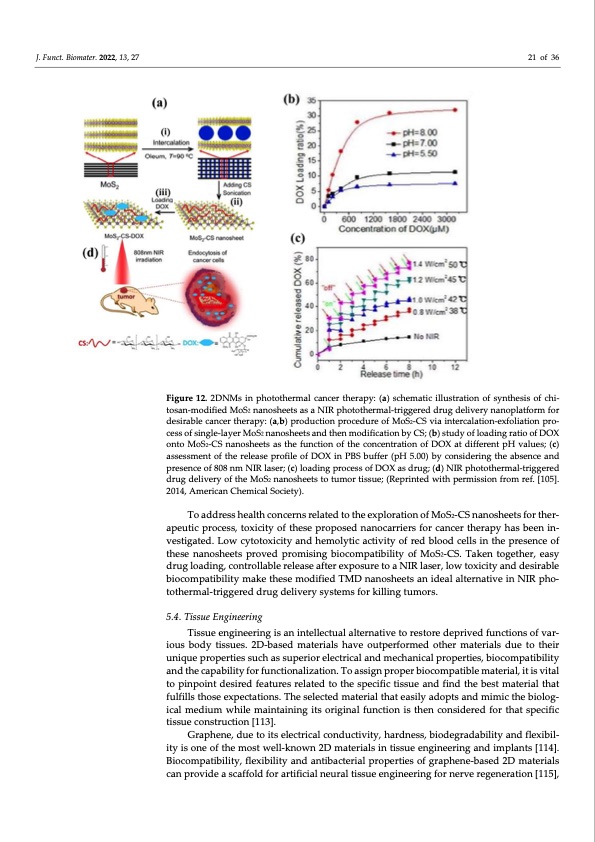
PDF Publication Title:
Text from PDF Page: 021
J. Funct. Biomater. 2022, 13, 27 21 of 36 Figure 12. 2DNMs in photothermal cancer therapy: (a) schematic illustration of synthesis of chi- tosan-modified MoS2 nanosheets as a NIR photothermal-triggered drug delivery nanoplatform for desirable cancer therapy: (a,b) production procedure of MoS2-CS via intercalation-exfoliation pro- cess of single-layer MoS2 nanosheets and then modification by CS; (b) study of loading ratio of DOX onto MoS2-CS nanosheets as the function of the concentration of DOX at different pH values; (c) assessment of the release profile of DOX in PBS buffer (pH 5.00) by considering the absence and presence of 808 nm NIR laser; (c) loading process of DOX as drug; (d) NIR photothermal-triggered drug delivery of the MoS2 nanosheets to tumor tissue; (Reprinted with permission from ref. [105]. 2014, American Chemical Society). To address health concerns related to the exploration of MoS2-CS nanosheets for ther- apeutic process, toxicity of these proposed nanocarriers for cancer therapy has been in- vestigated. Low cytotoxicity and hemolytic activity of red blood cells in the presence of these nanosheets proved promising biocompatibility of MoS2-CS. Taken together, easy drug loading, controllable release after exposure to a NIR laser, low toxicity and desirable biocompatibility make these modified TMD nanosheets an ideal alternative in NIR pho- tothermal-triggered drug delivery systems for killing tumors. 5.4. Tissue Engineering Tissue engineering is an intellectual alternative to restore deprived functions of var- ious body tissues. 2D-based materials have outperformed other materials due to their unique properties such as superior electrical and mechanical properties, biocompatibility and the capability for functionalization. To assign proper biocompatible material, it is vital to pinpoint desired features related to the specific tissue and find the best material that fulfills those expectations. The selected material that easily adopts and mimic the biolog- ical medium while maintaining its original function is then considered for that specific tissue construction [113]. Graphene, due to its electrical conductivity, hardness, biodegradability and flexibil- ity is one of the most well-known 2D materials in tissue engineering and implants [114]. Biocompatibility, flexibility and antibacterial properties of graphene-based 2D materials can provide a scaffold for artificial neural tissue engineering for nerve regeneration [115],PDF Image | Nanomaterials beyond Graphene for Biomedical Applications

PDF Search Title:
Nanomaterials beyond Graphene for Biomedical ApplicationsOriginal File Name Searched:
jfb-13-00027.pdfDIY PDF Search: Google It | Yahoo | Bing
CO2 Organic Rankine Cycle Experimenter Platform The supercritical CO2 phase change system is both a heat pump and organic rankine cycle which can be used for those purposes and as a supercritical extractor for advanced subcritical and supercritical extraction technology. Uses include producing nanoparticles, precious metal CO2 extraction, lithium battery recycling, and other applications... More Info
Heat Pumps CO2 ORC Heat Pump System Platform More Info
| CONTACT TEL: 608-238-6001 Email: greg@infinityturbine.com | RSS | AMP |